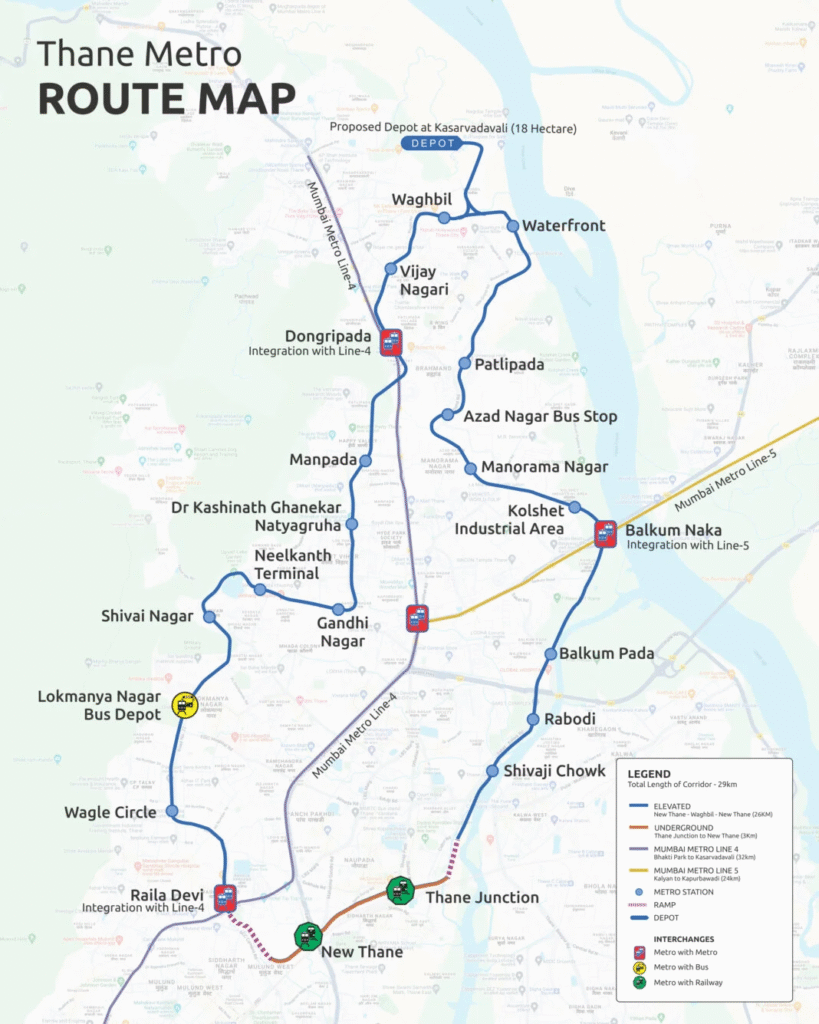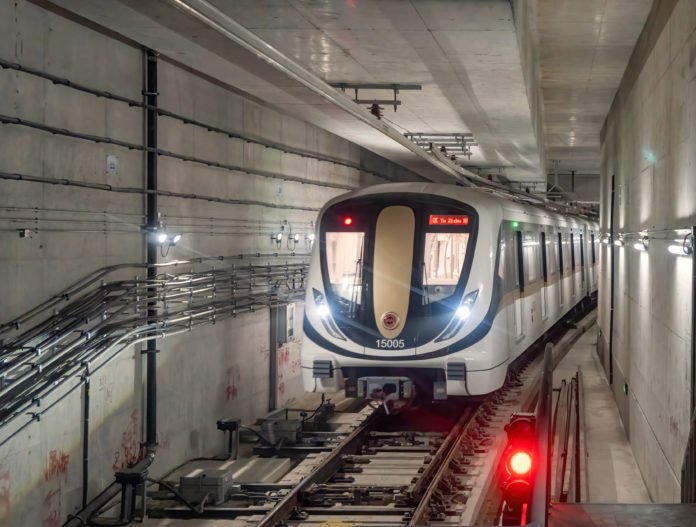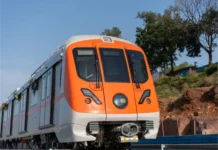About Thane
Thane, formerly known as Thana, is a metropolitan city situated in the northwestern part of Maharashtra, India, and to the northeast of Mumbai. It forms part of the Mumbai Metropolitan Region and serves as a neighbourhood and residential suburb of Mumbai. The city is located in the northeastern section of Salsette Island. According to the 2011 census, Thane was ranked the 15th most populous city in India with a population of approximately 1.89 million. Over time, Thane’s economy has shifted from manufacturing-based industries such as engineering, textiles, and chemicals to a more service-oriented structure.
Thane’s Urban Growth and the Critical Need for Metro Transit

Over the years, the population of Thane has increased dramatically from 1950 to 2025, with numbers rising from around 100,000 to more than 21 million. This rapid urban expansion reflects Thane’s transformation into a major metropolitan hub, which has increased the pressure on the infrastructure and transportation systems of the city. The population increase and economic diversification have put additional strain on the city’s transport system. Road congestion and longer travel times have highlighted the need for efficient public transit. In response, the establishment of a metro system was considered the best solution to support this growth. The metro system will provide reliable connectivity, which will reduce road traffic and improve the quality of life for residents.
Thane Metro: A Journey from Heavy Metro to Metrolite and Return
- The Thane Metro project was initially planned as a regular heavy metro line, with the foundation stone laid by the Prime Minister in December 2018.
- However, due to cost concerns, the heavy metro plan was scrapped in 2019. Subsequently, in early 2020, the project was resurrected as a metrolite or light rail transit (LRT) system to reduce expenses. This redesign involved reducing the train coach count and other cost-cutting measures.
- Yet, in 2023, the project was again reassessed and redesigned back into a regular heavy metro line to better meet the city’s transportation demands.
Thane Metro: Improving Connectivity and Urban Mobility
The Thane Metro Phase 1 project, officially named the Thane Integral Ring Metro, is a 29 km mass rapid transit system (MRTS) designed with a single circular line encompassing 22 stations. The 29-km corridor will run along the periphery of the west side of Thane city.
The project is being executed by the MahaMetro (Maharashtra Metro Rail Corporation Limited). The project received formal approval from India’s Central Government in August 2024. The project is estimated to cost ₹12,000 crore. The Project is likely to be completed by 2029.
Key Features of Thane Metro Project
| Authorised Authority | Maharashtra Metro Rail Corporation Limited |
| Estimated Cost | Rs. 12,000 Crore |
| Track | Standard Gauge: 1435 mm |
| Electrification | 25 kV, 50 Hz AC OHE |
| Signalling | Communication-based Train Control (CBTC) |
| Estimated Ridership | 6.47 lakh in 2029 |
| 7.61 lakh in 2035 | |
| 8.72 lakh in 2045 |
Route Details of Thane Metro
| Operational | 0 km |
| Under Construction | 0 km |
| Proposed | 29 km |
- Length: 29 km
- Type: Elevated (primarily) and Underground (2-3 km)
- Number of Stops/Stations: 22
- Station Names: Raila Devi, Wagle Circle, Lokmanya Nagar Bus Depot, Shivaji Nagar, Neelkanth Terminal, Gandhi Nagar, Dr. Kashinath Ghanekar Natyagraha, Manpada, Dongripada, Vijaynagari, Waghbil, Waterfront, Patlipada, Azad Nagar Bus Stop, Manorma Nagar, Kolshet Industrial Area, Balkum Naka, Balkumpada, Rabodi, Shivaji Chowk, Thane Junction (underground) and New Thane (underground).

Contractor’s List
| Contract | Contractor |
| Consul-01: General Consultant (GC) for Thane Metro | AECOM India |
| Geo-01: Geotechnical Investigation for Thane Metro | Renuka Consultants |
| DDC-01: Detailed Design Consultancy Services for 6 (Six) elevated stations at Dr. Kashinath Ghanekar Natyagraha, Manpada, Dongripada, Vijay Nagari, Waghbil and Waterfront, of Thane Integral Ring Metro Project | STUP Consultants Pvt. Ltd. |
Update on Thane Metro Project
- All the preliminary works for the Thane Metro Rail Project have been successfully completed. This includes utility mapping using Ground Penetrating Radar (GPR), UAV surveys for precise aerial mapping, detailed geotechnical investigations to assess soil and ground conditions, comprehensive topographic surveys to capture terrain features, and the preparation of the alignment design.
Impacts of the Thane Metro Project
- Traffic Decongestion: The Thane Metro project is projected to ease traffic congestion and enhance connectivity, particularly for daily commuters, students, and office workers. According to traffic studies, the system is expected to handle a Peak Hour Peak Direction Traffic (PHPDT) of 23,320 and a daily ridership of approximately 647,000 by its anticipated completion in 2029. By 2035, ridership demand is projected to increase to a PHPDT of 29,489 and a daily ridership of 761,000. Further growth is estimated by 2045, with projections indicating a PHPDT of 31,393 and a daily ridership of around 872,000.
- Travel Time: The project will connect major residential and commercial hubs like Wagle Estate, Ghodbunder, Kolshet, and Saket. This connectivity will drastically reduce commuting time for thousands of daily commuters.
- Multi-Modal Integration: The metro will be integrated with the Mumbai Metro Line 4 (Wadala–Kasarvadavali) and Line 5 (Thane–Bhiwandi–Kalyan), as well as the existing suburban railway network at Thane Station. This multimodal integration will create a comprehensive transit system, improving regional connectivity.
- Real Estate Dynamics: The Thane Metro is expected to influence the city’s real estate dynamics across residential, commercial, and land-use segments. On the residential side, areas such as Wagle Estate, Kolshet, Balkum, LBS Road, and Rabodi are likely to see higher demand due to better accessibility and reduced commuting time to employment hubs in Thane and Mumbai. This may encourage the development of affordable and mid-segment housing, while also supporting the adoption of transit-oriented development (TOD) models that promote higher-density and mixed-use projects around station precincts.
- Boost to Economic Activity: In terms of commercial activity, enhanced connectivity will make Thane more viable for corporate offices, IT parks, and service-based enterprises. MSMEs and startups in particular are expected to benefit from better workforce access. Key commercial corridors, including Ghodbunder Road and LBS Road, may also experience stronger absorption of retail and office spaces as footfall and connectivity improve.
Conclusion
The Thane Metro Project is a strategically planned infrastructure initiative which aims to address the city’s growing urban mobility challenges. This metro line will be the third to operate across Thane City. Once operational, it will connect residential neighborhoods, industrial zones, commercial hubs, and key transport nodes, forming a high-capacity transit corridor. By integrating with Mumbai Metro Lines 4 and 5 and the suburban rail network at Thane Station, the project is designed to create a seamless multimodal transport system that will enhance regional connectivity. Beyond easing congestion, the metro is expected to support transit-oriented development, facilitate organised urban expansion, and improve access to employment, education, and essential services. With projected ridership rising from 6.47 lakh in 2029 to 8.72 lakh by 2045, the Thane Metro shows potential to sustainably manage future transport demand and contribute to the city’s economic and social development within the Mumbai Metropolitan Region.





